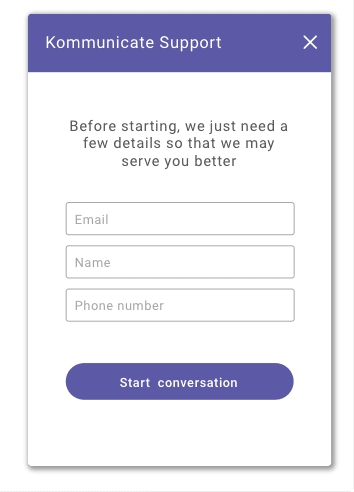Authentication
Last updated
Was this helpful?
Last updated
Was this helpful?
In this section, you can get the instructions to authenticate the users coming to the chat. You can set how users are identified and authenticated. You can also set up lead collection forms to get information from the users before initializing the chat.
You can set and update user details in kommunicateSettings function in the Kommunicate chat plugin script.
Here are the parameters you can pass in the to add the user information:
Parameters
Type
Description
userId
String
This is your user’s/visiter's ID. Kommunicate will generate a random ID if this is not defined.
userName
String
This is the display name of the user. Your team will identify the user by this display name.
String
Email ID of the user. If not online, the user will be notified by fallback emails sent to this email ID.
password
String
This will be User's password.
imageLink
String
This will be the profile image of the user.
conversationTitle
String
All conversations will have this title. Once the conversation is assigned to one of your team, their name would come as the conversation title.
defaultMessageMetaData
Object
This will send defaultMessageMetaData with every message
authenticationTypeId
Integer
There are 3 ways to log in users into the chat.
Whenever users come to your website, they are assigned a random ID by default. This behavior is best suited for anonymous users. Your anonymous users will be identified by pseudonyms. Our pseudonyms structure contains an adjective with a sea-creature name (For example, Jolly Shellfish). Add the below-mentioned setting to allow anonymous users into the chat:
Parameters
Description
appId
A unique application ID assigned to your Kommunicate account.
conversationTitle
All conversations will have this title. Once the conversation is assigned to one of your team members, their name would come as the conversation title.
For collecting users' contact information before initiating the chat, use the preLeadCollection method. Once configured, users will see the form on click of the chat widget launcher icon.
NOTE: At least one of the (name, email, phone) fields is required.
You can collect any custom information from the users as well. Just add the object for that particular information in the code. Let's say you want to collect your user's employment information, you can add that field in a similar manner.
If the user has already logged into your website previously, then pass the user details to Kommunicate using the following setting:
Parameters
Description
userId
It is the unique identifier for any user, it can be anything like email, phone number or uuid from your database.
Note: Spacing and set of special characters^!$%^&*() are not accepted in this parameter.
userName
Display name of the user. Your team will identify the user by this display name.
Email ID of logged in user.
password
Password of logged in user.
authenticationTypeId
Once the chat plugin is initialized and has returned success response, then you can use Kommunicate.updateUser(userdetail) method to update the user's details.
parameters
description
Email ID to be updated.
displayName
Display name of the user. Your team will identify the user by this display name.
imageLink
This will be the profile image of the user.
metadata
It is the extra information about the user. You can pass information such as the user's company name and designation. This information will be visible to your team in the Kommunicate dashboard.
You can use this to authenticate userId and password from your server and pass the value of 'authenticationTypeId' as "0" (Optional).
NOTE: APP_ID is a unique application ID assigned to your Kommunicate account. You can get it from the in Kommunicate Dashboard. Example:
Default: 1 ,you can pass 1 for password verification from Kommunicate server and 0 for access token verification from server.
User details can be sent to the bot platform by initializing a chatContext object with all the user details parameter and append it to Kommunicate settings by calling Kommunicate.updateChatContext . The right place to call this process is where you pass the onInit function in the .
